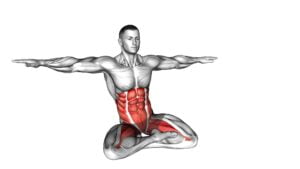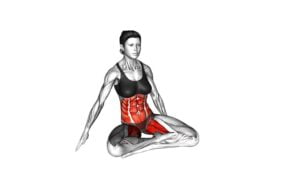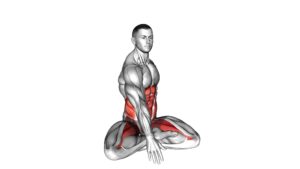Sitting Lotus Pose Hip Horizontal Rotation – Video Exercise Guide & Tips

Are you looking to improve your hip flexibility and rotation? Look no further than the Sitting Lotus Pose Hip Horizontal Rotation.
Watch This Exercise Video
In this video exercise guide, we will show you how to properly perform this pose, along with modifications and variations for all skill levels.
Avoid common mistakes and learn tips for incorporating this pose into your yoga routine.
Get ready to feel the benefits of increased hip mobility and find your inner zen.
Let's get started!
Key Takeaways
- Increased flexibility in the hips
- Greater range of motion and stability in yoga poses
- Release of tension and improved mobility in the hip joints
- Alleviation of tightness and discomfort
Benefits of Sitting Lotus Pose Hip Horizontal Rotation
You can experience increased flexibility in your hips by practicing the Sitting Lotus Pose Hip Horizontal Rotation. Hip flexibility is crucial in yoga as it allows for a greater range of motion and stability in various poses.
The Sitting Lotus Pose, also known as Padmasana, is a seated posture commonly used for meditation. It involves crossing your legs and placing each foot on the opposite thigh. By incorporating the Hip Horizontal Rotation into this pose, you can enhance the benefits of both hip flexibility and meditation.
The Sitting Lotus Pose Hip Horizontal Rotation specifically targets the hip joints, helping to release tension and improve mobility. As you rotate your hips in this exercise, you're stretching the muscles and connective tissues surrounding the joints. This can alleviate tightness and discomfort, allowing you to sit more comfortably in the Lotus Pose for longer periods of time.
Additionally, the connection between the Sitting Lotus Pose and meditation is significant. The Lotus Pose is often used as a meditation posture due to its ability to promote a sense of grounding and stability. By increasing hip flexibility through the Hip Horizontal Rotation, you can find even greater ease and comfort in your meditation practice.
How to Perform Sitting Lotus Pose Hip Horizontal Rotation
To perform the Sitting Lotus Pose Hip Horizontal Rotation, start by sitting in a comfortable cross-legged position with your hands resting on your knees. This pose is great for improving flexibility and using hip opening techniques.
Follow these steps to properly perform the pose:
- Begin in a seated position with your legs crossed, placing your right foot on top of your left thigh and your left foot on top of your right thigh.
- Relax your shoulders and lengthen your spine, keeping your chest lifted and your core engaged.
- Place your hands on your knees and take a deep breath in.
- As you exhale, gently rotate your hips in a horizontal circular motion, first in one direction and then in the other. Be sure to keep your upper body stable and your breath steady throughout the movement.
Modifications and Variations for All Skill Levels
There are several modifications and variations available for practitioners of all skill levels for the Sitting Lotus Pose Hip Horizontal Rotation.
If you're a beginner, it's important to start with modifications that will help you build strength and flexibility gradually. One modification you can try is sitting on a folded blanket or bolster to elevate your hips and reduce strain on your knees. This can be especially helpful if you have tight hips or knee issues.
Another modification is to use a strap or towel to help support your knees and keep them from splaying out to the sides. This can provide additional stability and support as you work on opening your hips.
For those who are more advanced in their practice, there are several variations that can challenge and deepen the pose. One option is to incorporate a twist by placing one hand on the opposite knee and gently rotating your torso in the direction of the twist. This can help to increase the stretch in your hips and improve spinal mobility.
Another variation is to add a bind by reaching one arm behind your back and the other arm over your shoulder to clasp hands. This can further open your chest and shoulders while adding a strengthening element to the pose.
Remember to listen to your body and only go as far as feels comfortable for you. With consistent practice and patience, you'll be able to progress in your Sitting Lotus Pose Hip Horizontal Rotation.
Common Mistakes to Avoid During Sitting Lotus Pose Hip Horizontal Rotation
One common mistake to avoid during the Sitting Lotus Pose Hip Horizontal Rotation is improper alignment. When performing this pose, it's important to maintain proper alignment in order to avoid injuries and maximize the benefits of the exercise.
Here are some common mistakes to avoid:
- Misalignment of the hips: Ensure that your hips are squared and level throughout the rotation. Avoid allowing one hip to lift higher than the other, as this can strain the lower back and lead to discomfort or injury.
- Lack of engagement in the core: Remember to engage your core muscles throughout the movement. This will help to stabilize your body and protect your lower back from strain.
- Forcing the rotation: Don't force the rotation of your hips beyond what feels comfortable for your body. Pushing too hard can lead to strain or injury. Instead, focus on gradually increasing your range of motion over time.
- Neglecting to breathe deeply: Deep breathing is essential during this pose, as it helps to relax your body and deepen the stretch. Avoid shallow breathing and instead, take slow, deep breaths as you rotate your hips.
Tips for Incorporating Sitting Lotus Pose Hip Horizontal Rotation Into Your Yoga Routine
To incorporate Sitting Lotus Pose Hip Horizontal Rotation into your yoga routine, focus on slowly and mindfully rotating your hips while maintaining proper alignment and engaging your core muscles. This exercise is a great way to improve hip flexibility, which is crucial in a yoga practice. Flexible hips not only enable you to move more freely and comfortably in various poses, but they also help prevent injuries and allow for a deeper range of motion.
In addition to the physical benefits, there's a strong connection between sitting lotus pose and mindfulness meditation. The lotus pose is often used as a seated position for meditation because it helps create a sense of stability and grounding. By incorporating hip horizontal rotation into this pose, you can further enhance your ability to focus and be present in the moment.
When practicing sitting lotus pose hip horizontal rotation, it's important to listen to your body and never force any movements. Start with gentle rotations and gradually increase the range of motion as your hips become more flexible. Remember to maintain proper alignment by sitting up tall, relaxing your shoulders, and keeping your spine straight. Engage your core muscles to support your lower back and maintain stability throughout the rotation.
Incorporating sitting lotus pose hip horizontal rotation into your yoga routine can bring numerous benefits, both physically and mentally. By practicing with mindfulness and patience, you can improve your hip flexibility and cultivate a sense of calm and focus in your practice.
Frequently Asked Questions
What Are the Benefits of Practicing Sitting Lotus Pose Hip Horizontal Rotation for Pregnant Women?
Practicing sitting lotus pose hip horizontal rotation can offer numerous benefits for pregnant women. This exercise helps to open up the hips, increase flexibility, and strengthen the pelvic floor muscles. It also promotes better digestion, relieves lower back pain, and improves overall posture.
However, it's important to modify this pose if you have knee injuries. To do so, you can place a blanket or cushion underneath your knees for support and lessen the pressure on your joints.
Can Sitting Lotus Pose Hip Horizontal Rotation Help With Back Pain?
Sitting lotus pose hip rotation can be beneficial for back pain relief. By engaging your core and stretching the muscles in your hips and lower back, this exercise helps to improve flexibility and strengthen the supporting muscles.
The hip rotation motion also helps to release tension in the spine, reducing discomfort. Incorporating sitting lotus pose hip rotation into your routine can provide you with the added benefit of alleviating back pain and promoting overall spinal health.
Is It Safe to Practice Sitting Lotus Pose Hip Horizontal Rotation if I Have Knee Injuries?
If you have knee injuries, it's important to practice sitting lotus pose hip horizontal rotation with caution. While this exercise can be beneficial for hip opening, it may put strain on your knees.
To make it knee-friendly, consider modifying the pose or exploring other hip openers that are safer for your knees.
Always listen to your body and consult with a professional before attempting any new exercises or modifications.
How Long Should I Hold the Pose During Sitting Lotus Pose Hip Horizontal Rotation?
To improve flexibility in sitting lotus pose, it's important to hold the pose for an adequate amount of time. The duration of the pose will vary depending on your level of comfort and flexibility.
Start by holding the pose for a few breaths and gradually increase the time as you become more comfortable. Remember to listen to your body and never push yourself too far.
Avoid common mistakes like forcing yourself into the pose or applying excessive pressure on your knees.
Are There Any Contraindications or Precautions to Be Aware of When Practicing Sitting Lotus Pose Hip Horizontal Rotation?
When practicing sitting lotus pose hip horizontal rotation, it's important to be aware of any contraindications or precautions.
Contraindications refer to any conditions or injuries that may be worsened or aggravated by this exercise.
Precautions, on the other hand, are measures you should take to ensure your safety and prevent any potential injuries.
Conclusion
Incorporating the sitting lotus pose hip horizontal rotation into your yoga routine can provide numerous benefits for your body and mind.
This exercise helps improve hip flexibility, release tension in the lower back, and promote a sense of calm and relaxation.
By following the correct technique and avoiding common mistakes, you can safely perform this pose at any skill level.
So why not give it a try and experience the transformative power of the sitting lotus pose hip horizontal rotation in your own practice?

Author
Years ago, the spark of my life’s passion ignited in my mind the moment I stepped into the local gym for the first time. The inaugural bead of perspiration, the initial endeavor, the very first surge of endorphins, and a sense of pride that washed over me post-workout marked the beginning of my deep-seated interest in strength sports, fitness, and sports nutrition. This very curiosity blossomed rapidly into a profound fascination, propelling me to earn a Master’s degree in Physical Education from the Academy of Physical Education in Krakow, followed by a Sports Manager diploma from the Jagiellonian University. My journey of growth led me to gain more specialized qualifications, such as being a certified personal trainer with a focus on sports dietetics, a lifeguard, and an instructor for wellness and corrective gymnastics. Theoretical knowledge paired seamlessly with practical experience, reinforcing my belief that the transformation of individuals under my guidance was also a reflection of my personal growth. This belief holds true even today. Each day, I strive to push the boundaries and explore new realms. These realms gently elevate me to greater heights. The unique combination of passion for my field and the continuous quest for growth fuels my drive to break new ground.







